Invented by Willard H. Waldron, Victoria L. Dravneek, Joseph N. Johansen, Darryl C. Goebel, Bank of America Corp
Virtual behavior training using AR user devices offers a unique and effective way to train individuals in areas such as healthcare, customer service, sales, and even public speaking. By simulating real-life scenarios, users can practice and improve their skills in a safe and controlled environment.
One of the key advantages of this technology is its ability to provide realistic and engaging training experiences. With the help of AR user devices, trainees can interact with virtual objects and characters that appear in their real-world surroundings. This creates a sense of presence and allows for a more immersive learning experience.
In the healthcare industry, virtual behavior training using AR user devices has proven to be particularly beneficial. Medical professionals can practice complex procedures, such as surgeries, without the risk of harming real patients. This technology also allows for the simulation of rare or challenging cases that may not be readily available for training purposes.
Similarly, in the customer service and sales sectors, AR user devices enable employees to practice their communication and problem-solving skills in various scenarios. They can interact with virtual customers and learn how to handle different situations effectively. This type of training can greatly enhance the overall customer experience and improve employee performance.
Public speaking is another area where virtual behavior training using AR user devices can be highly effective. Many individuals struggle with public speaking, and this technology offers a safe space to practice and improve their presentation skills. Users can simulate speaking in front of a large audience and receive real-time feedback on their performance, helping them gain confidence and refine their delivery.
The market for virtual behavior training using AR user devices is expected to continue growing in the coming years. The advancements in technology, such as the development of more affordable and user-friendly devices, have made this training method more accessible to a wider range of industries and individuals.
Furthermore, the COVID-19 pandemic has accelerated the adoption of virtual training solutions, including AR user devices. With the limitations on in-person training and the need for remote learning, organizations have turned to virtual behavior training as a viable alternative. This has further fueled the demand for AR user devices and related software.
However, there are still some challenges that need to be addressed for the market to reach its full potential. The cost of AR user devices and the development of high-quality training content can be barriers for some organizations. Additionally, ensuring the accuracy and effectiveness of the virtual training experiences is crucial to maximize the benefits.
In conclusion, the market for virtual behavior training using augmented reality user devices is rapidly expanding. This technology offers a unique and effective way to train individuals in various fields, providing realistic and immersive learning experiences. With the advancements in technology and the increasing demand for remote training solutions, the future of this market looks promising.
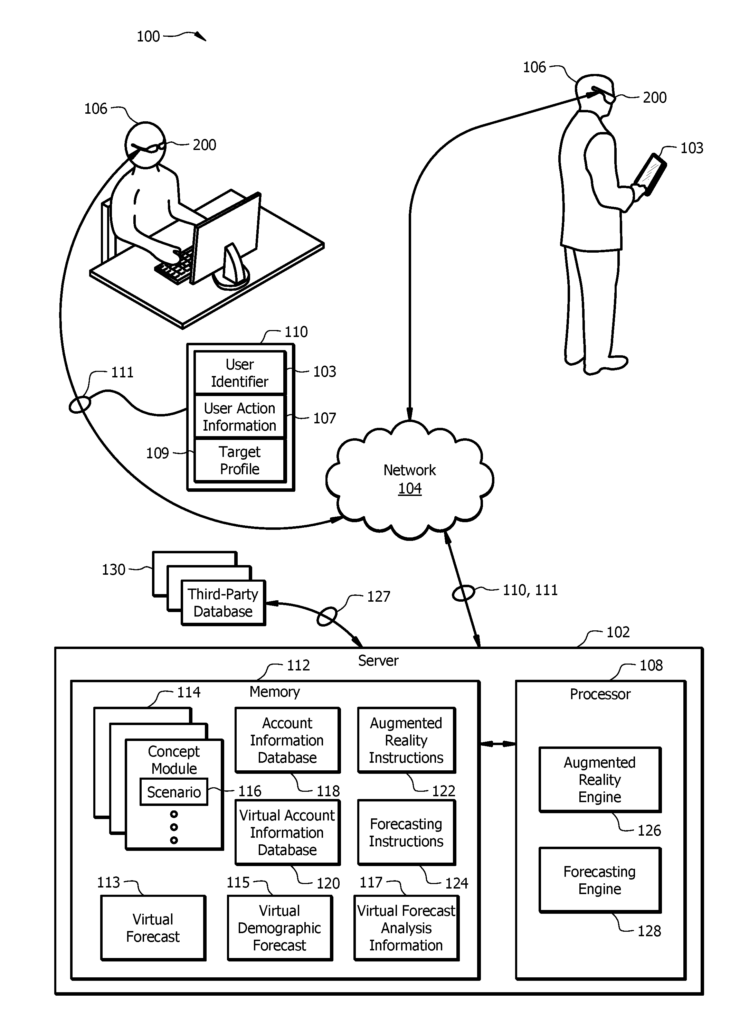
The Bank of America Corp invention works as follows
An augmented-reality system including an augmented-reality user device.” The augmented reality device has a display that overlays virtual objects on tangible objects in real scenes and a memory for scenarios. The augmented reality device has a processor that implements a virtual assessment and overlay engine. The virtual assessment engine identifies the user’s identifier and executes the scenario for the users. The virtual assessment engine identifies the actions taken by the user in relation to the scenario. The virtual assessment engine transmits a token containing the user’s identifier, user action information and the information about the user to a server remote and receives the information from the server. The virtual overlay engine displays the information as virtual objects superimposed on the real scene.
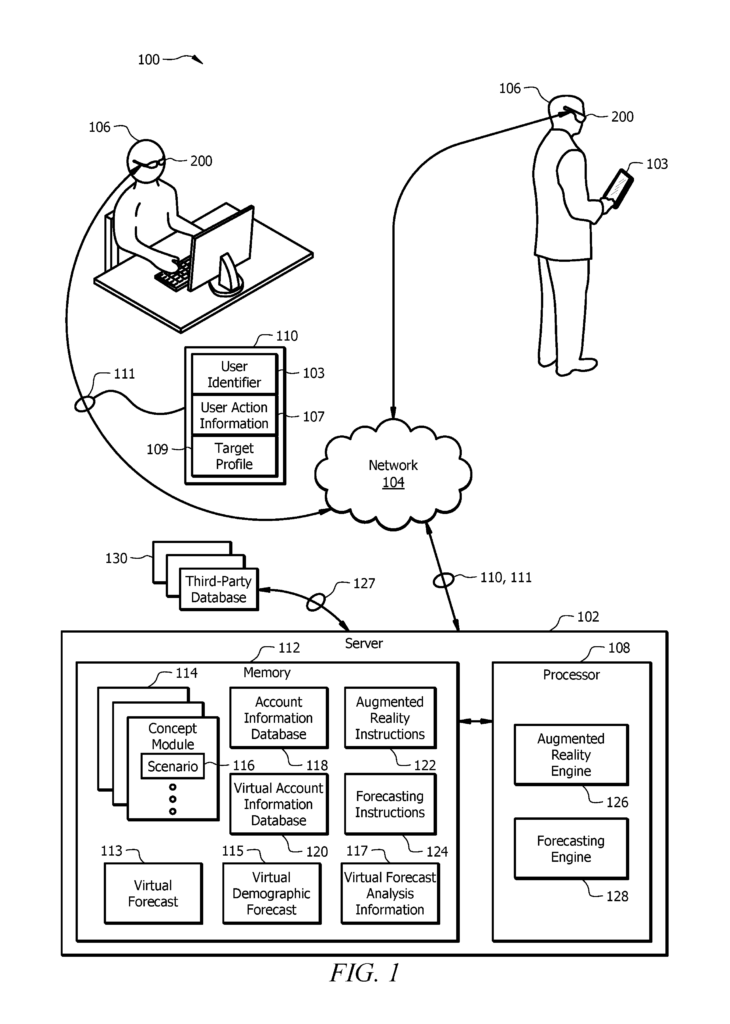
Background for Virtual Behavior Training using Augmented Reality User Devices
Existing systems display information using two-dimensional graphic user interfaces. The use of conventional two-dimensional graphic user interfaces for displaying information has several inherent technical limitations and problems. Existing two-dimensional graphic user interfaces, for example, limit the amount information a person can view based on display size. The person may also have to interact multiple windows or screens of the graphical interface in order to see all the information that is relevant to them. The information presented is not in line with the real world when using existing graphical interfaces. It would be desirable to have the option to reduce the gap between the information presented and the real-world environment.
In one embodiment, disclosure includes an augmented-reality system and an augmented-reality user device for the user. The augmented reality device includes a display that overlays virtual objects on tangible objects within a real scene, in real time. The augmented reality device has a memory for storing scenarios. “The augmented reality device also includes one or multiple processors that are connected to the memory and display.
The processors implement both a virtual assessment and overlay engine. In response to successful authentication, the virtual assessment engine identifies the user’s identifier. The virtual assessment engine selects one scenario for the user from a plurality. The virtual assessment engine identifies the actions taken by the user, and determines if the actions are related to a scenario.
The virtual assessment engines generates user action data which identifies both the user and scenario when user actions are associated with the scenario. The virtual assessment engine creates a token containing the user identifier, the user action information, and sends it to a remote client. The virtual assessment engine, in response to sending the token to the remote servers, receives virtual assessment information including virtual account data and account information for users. The virtual overlay engine displays the virtual assessment data overlaid on a real scene.
The augmented-reality system also includes the remote server, which includes an augmented-reality engine.” The augmented-reality engine identifies both the virtual account and account information of the user using the user ID. The augmented-reality engine modifies virtual account information in accordance with the information about user actions. The augmented-reality engine creates virtual assessment data, which includes the modified virtual account data and the account data for the user. It then sends this virtual assessment data to augmented reality device.
In one embodiment, a augmented reality device allows the user to use concept modules and scenario while monitoring their actions in the real-world. The augmented reality device uses concept modules and scenario to teach the user how certain actions or behaviors impact them. The concept modules and scenario provide information on actions or behaviors that a user can take to improve his or her current knowledge, skill set, or behavior. The augmented reality device monitors and analyses the user’s action and determines if the user performs actions related to the concept module and scenario he or she is interacting. The augmented reality device can then automatically verify and identify when the user performs actions that are identified by the scenario or concept module.
The augmented reality device gathers information on actions taken by the user in relation to a scenario or concept module and updates the virtual account and/or other account information based upon the information collected. The augmented reality device may credit the user’s account or other accounts when the user takes responsible decisions and completes the tasks identified in a scenario. The augmented reality device can penalize a user’s virtual or other accounts if they make poor decisions, do not complete tasks outlined in a scenario, etc.
The augmented-reality user device receives modified account information or account information from a remote computer. The augmented reality device displays the modified virtual information or account information as virtual objects on top of tangible objects in the real scene. The augmented reality device allows users to view the impact of their real-time actions within the context of the virtual world. The user can, for example, see the impact of certain actions or behaviors on their virtual accounts or other accounts.
In another embodiment, the user device for augmented reality allows an individual to see their projected account data. The augmented reality device aggregates user account information, such as balances. The augmented reality device aggregates data about the user. Account information, such as payment and transaction histories, can be used to determine the user’s habits. The augmented reality device displays projected account information overlaid on tangible objects in the real scene before the user. In one embodiment, augmented reality device displays projected account information in the form of virtual objects that represent physical objects. The augmented reality device, for example, presents virtual objects that represent a lifestyle that matches the account information of the user. The augmented reality device can also be used to visualize the goals of the future account. The augmented reality device lets the user see how their actions and decisions affect their projected future account balances. The augmented reality device, for example, allows the user visualize the outcome of certain decisions like saving or investing. The augmented reality device helps educate users about the impact of certain types of actions and behaviors on the user’s future goals.
The conventional systems provide only raw numbers about the user’s account, such as balances. Contrary to conventional systems the augmented reality device offers an unconventional solution, allowing the user to see the raw data in the form of virtual objects that are matched with real objects and can be easily interpreted by users.
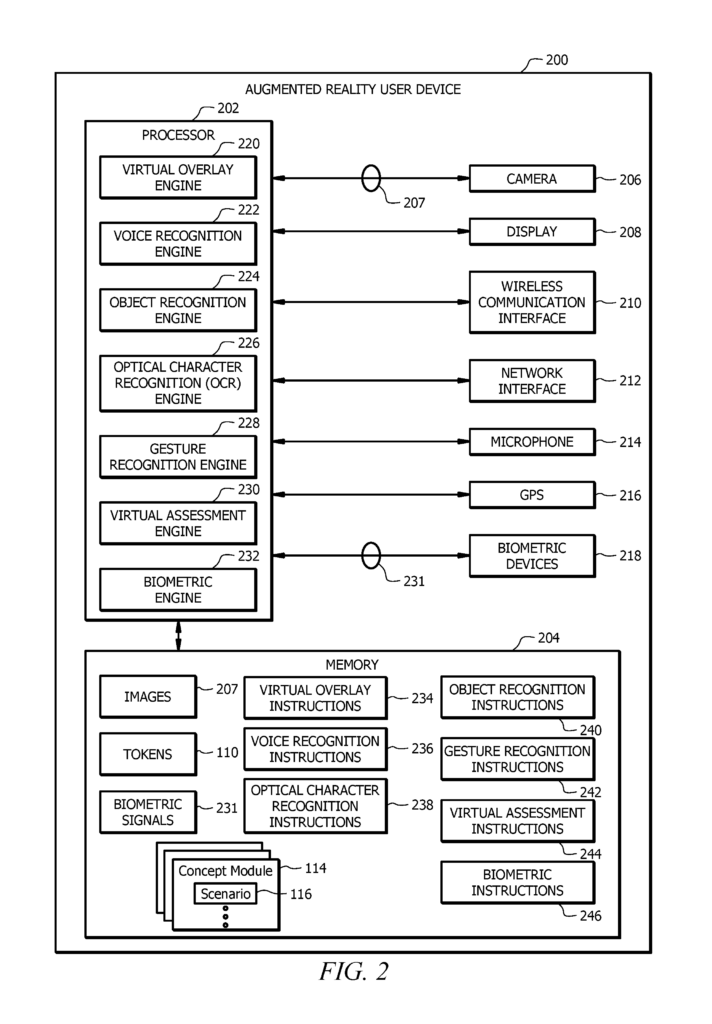
The present embodiment has several technical advantages. The augmented reality device has a technical advantage in that it allows the user to view information as a virtual or graphic object superimposed on the physical object. The augmented reality device allows the user to see a vast amount of data in context with the real scene before them. The augmented reality device shows the user the information received as virtual objects that are overlaid on the real scene. The augmented reality device allows users to view the impact of their actions as they occur in real time. The augmented reality device allows users to view raw data in a different way than typical systems. Number-based data can be represented as virtual objects which correspond to physical objects.
The augmented-reality user device generates tokens on the basis of an identity and actions of a particular user. This improves the performance by reducing the information required to make a request for data. Tokens can be encoded or encrypted to mask and obfuscate information that is being transmitted across a network. “By masking the data being transmitted, users are protected and their information is not compromised in the event that unauthorized access occurs to the network or data.
The augmented reality device uses optical character recognition and object recognition to identify the objects that the user is looking or interacting with. The augmented reality device can collect data faster by retrieving information about objects that the user interacts with. This is in comparison to other systems which rely on users manually entering all the required information. This method of collecting data autonomously reduces the possibility of errors by the user and increases the reliability of the system.
Certain embodiments of this disclosure may include all of these features, some of them, or none at all. The following detailed description, taken together with the accompanying illustrations and claims, will help you better understand these advantages and other features.
Existing systems use two-dimensional graphic user interfaces to present information to the user. The use of conventional two-dimensional graphic user interfaces for displaying information has several inherent limitations and technical problems. Existing two-dimensional graphic user interfaces, for example, limit the amount information a person can view based on display size. The person may also have to interact multiple screens or windows on the graphical interface to view the information they are interested in. The use of existing graphical interfaces, and the need to interact with several windows or screens, causes a disconnect between information and real-world environment.
An augmented-reality user device allows the user to view information in real time as a virtual or graphic object superimposed onto a physical object. The augmented reality device allows the user to see vast amounts of data in context with the real scene before them. The augmented reality device shows the information received to the user in the form of virtual objects that are overlaid on the real scene before the user. The augmented reality device enables the user to view the impact of their action in context with their real-time actions. The augmented reality device allows users to view raw data in a different way than conventional systems. Number-based data is represented as virtual objects which correspond to physical objects and can be easily interpreted by users. The augmented reality device offers a novel solution, by translating raw data first into virtual object representations for physical objects. These virtual objects are then presented in context with the real scene. This innovative solution lets the user see raw data without needing to understand or analyze it.
When a person wants to access data from multiple sources, this presents a technical challenge. The person might want to search for their personal data, but it is spread across different databases and sources. This can cause several technical issues. In order to get the information desired, the user must make separate data requests for each source using conventional systems. The process requires a large number of data requests from different data sources, which consumes a lot of processing resources. Processing resources are usually limited, and when they are used up the system cannot perform other tasks. This reduces its performance. This process, which involves sending multiple data requests and receiving the results from different sources, consumes network resources. This process is a drain on the network and degrades its performance.
Each data request can use different credentials for authentication of the person to each source. The complexity of the system increases when different credentials are provided to each source. This also increases the amount data sent over the network. Existing systems are difficult to manage due to the increased complexity. “The additional data sent over the network consumes more network resources, and also exposes sensitive information on the network.
The augmented reality device is a technical solution which allows the user to reduce data requests to get information from different sources. Image processing is used to extract data for the augmented reality device. The augmented reality device allows users to authenticate to access information. This allows them to ask for and receive personal information specific to themselves with the same data requests. The processing resources required to generate a reduced number of requests for data are less than those used by the existing systems to generate numerous requests. As a result, the overall performance of system improves. The amount of data traffic is reduced by reducing the number of requests for information. This results in better network utilization and performance.
Securely transferring data and other information across a computer network presents several technical challenges. Unauthorized users can attack networks to access sensitive information. Unauthorized access may compromise the security and confidentiality of data and information that is being transmitted across the network.
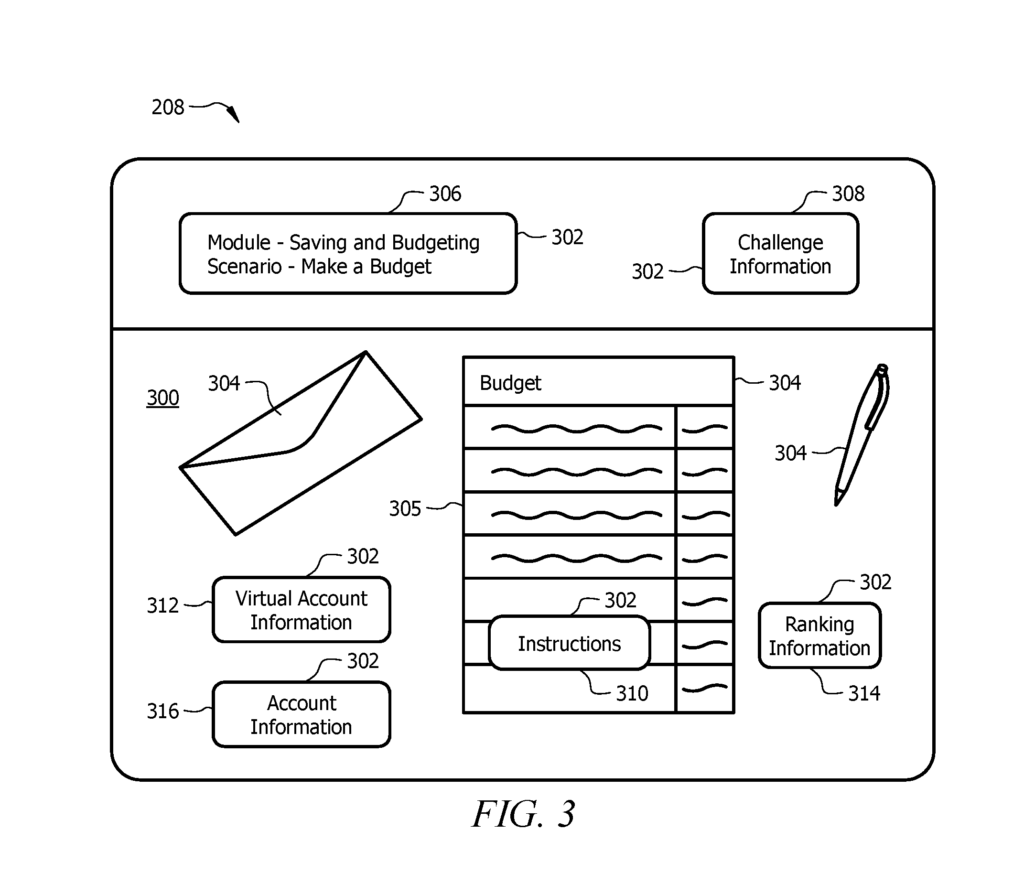
The augmented-reality user device is a technical solution to improve network security, by generating tokens and using them for the request of potentially sensitive information. The augmented reality device can generate tokens automatically when identifying and extracting data from the scene before the user. To obfuscate information, the token can be encoded or encrypted. By using tokens to hide information, users are protected from unauthorized access. Tokens allow data transfers to be performed using less information than existing systems and reduce the amount of data communicated across networks. By reducing the amount data communicated over the network, the performance is improved.
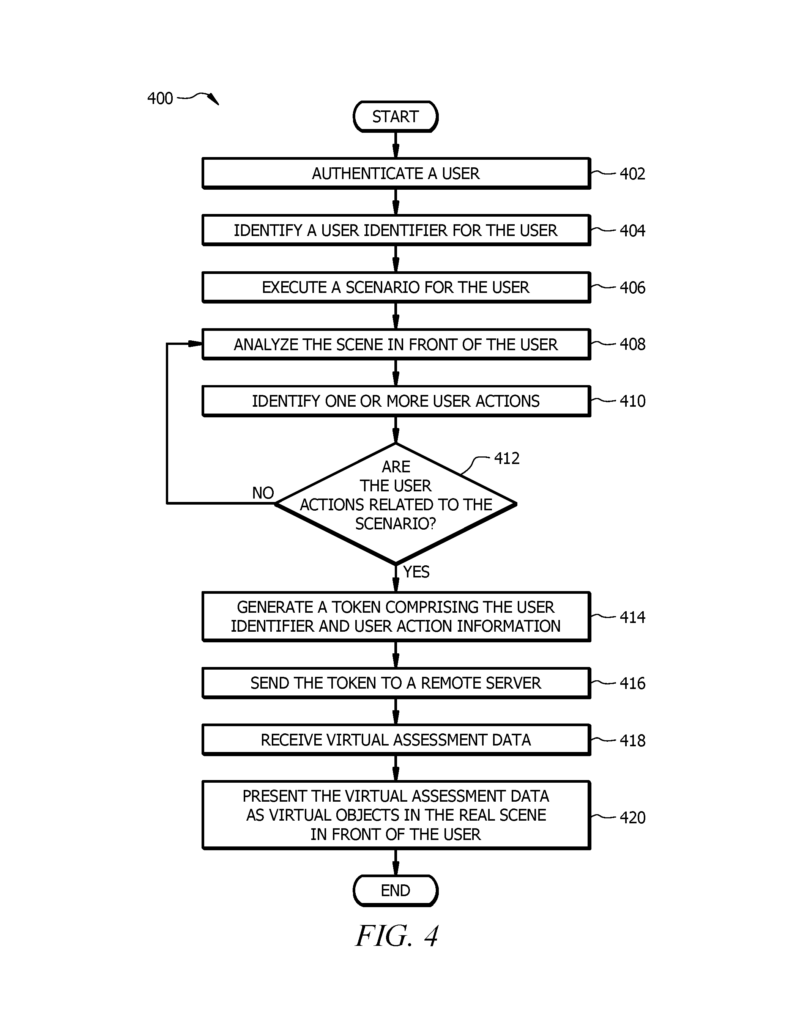
Click here to view the patent on Google Patents.
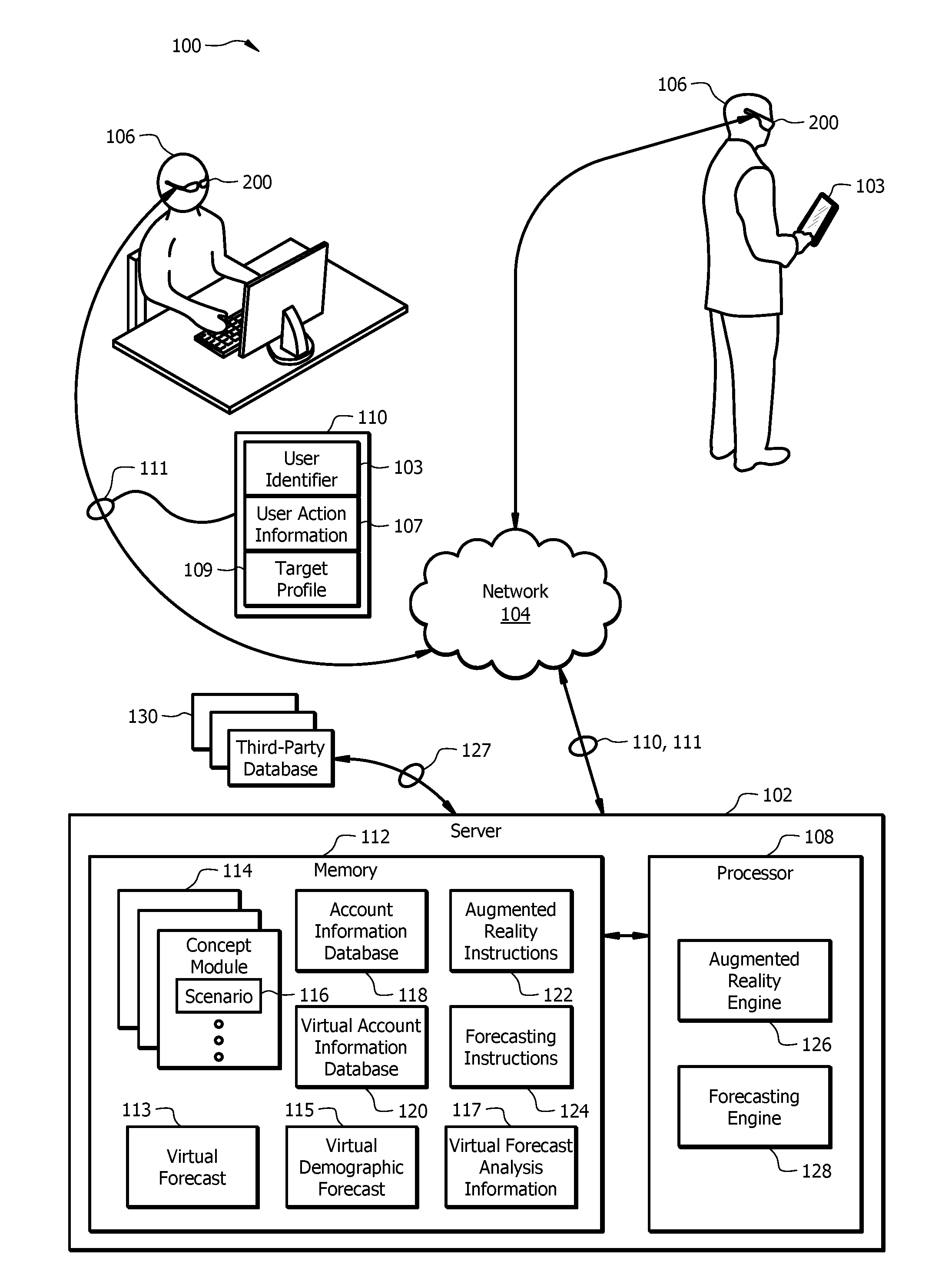
Leave a Reply